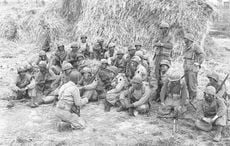The 1879 famine may not have seen the same levels of death and emigration as the Great Hunger (known in Irish as an Gorta Mór) just three decades earlier, but Ireland endured raging hunger that brought many in the west of Ireland to their knees.
The older population was, of course, still haunted by the painful memory of the 1845-1852 famine, which resulted in one million deaths nationwide and the emigration on 1.5 million others. As in that devastating time, they were facing a potato crop ravaged by blight and the fear of starvation and eviction returning to their door.
The 1879 famine affected mostly the west of Ireland. Co. Mayo endured the worst of it, the same county which experienced a 30 percent decline in its population during An Gorta Mór through death and migration. Many of the Mayo farmers were still reliant on the potato crop because the soil could not support any other crop sufficiently to provide enough food to feed their families. That meant when torrential rain fell in the the weeks before the harvest the telltale signs of browning leaves on the plants led to panic through the county. The Mayo people's panic was well founded as the harvest return was the lowest in a decade and under half the previous year's harvest.
With the help of the Land League, hundreds of thousands of dollars in American aid, and the extension of the railway system to most Mayo stations by 1870, however, the effects of the famine were less severe than in the late 1840s.
No major changes in land ownership in Ireland had taken place after the Great Hunger. When the 1879 famine brought yet more evictions of tenant farmers, moves were made to end the unfair system that saw only 750 families own half of Ireland's land. In 1870, as much as 97 percent of Irish farmland was owned by those who rented out their land to tenant farmers, many of whom regularly suffered the threat of eviction if they were unable to pay their rent.
Read more: Facts about Great Famine emigration out of Ireland revealed
In an attempt to bring about change to the unjust system, Michael Davitt, a Fenian (militant Irish nationalist), formed the Irish Land League in 1879 with Charles Stewart Parnell, a member of Parliament and a constitutional nationalist, as its president. The Land League began to wage war on the landlords and their agents so as to bring a radical change to the status quo and allow the tenant farmers to own their own land.
With tensions mounting, the Land War erupted between 1879 and 1882 until the 1881 Land Act granted fair rents and the possibility for tenants to purchase their land. The following year, Parnell agreed to end the Land War in return for the government's elimination of old, unpaid rents.
Thanks to the Land League, those suffering from the famine were now politically organized and had further support to prevent them being evicted, although evictions did still take place.
With the population already embittered following their treatment during the Great Hunger, the desire to fight back against the landlords strengthened, especially when they continued to treat their tennants unfairly and refused to compromise. (It should be noted that not all landlords and agents in Ireland treated their tenants with the same contempt shown by others, but they were still members of an unjust system.) It was the actions of men such as Lord Lucan who sealed the fate of landlords in Ireland, a man who refused to offer tenants a reduction in rent as this would have meant a cut in his living standards.
It was during this time that the word “boycott” was introduced to the English language. It was used as a tactic against the English Captain Charles Boycott, a land agent for Lord Erne who was a landowner in the Lough Mask area of County Mayo, when his tenants refused to harvest his crops until they were treated to more just terms.
Read more: How the Irish invented the boycott after tenants were thrown off their land
Read more: 50,000 Famine Irish in US were deported back to Ireland
Another significant factor in the less disastrous outcome of the 1879 famine was Irish America. As a result of the mass movement of hungry and poor Irish to the US during the Famine in the 1840s and 50s there was a large population of people in America ready and willing to help provide aid and publicize the need for a tremendous response.
The New York Tribune, in particular, gave significant coverage to the famine during 1879 and 1880 with the help of journalist James Redpath, who provided vivid descriptions of the misery in Ireland and urged the US to send help. Family members in America were already able to help their families at a home in a way that was not as possible in the early famine, sending money home to help their loved ones.
Harper’s Weekly featured major stories on the famine in early 1880, explaining Irish impoverishment and its roots in land ownership. "America is not slow to respond to a call for bread,” they asserted.
The greatest advocate for the Irish during this time was the New York Herald, which collected more than $200,000 by late February 1880. On March 27, 1880, the U.S. Department of Navy dispatched the U.S.S. Constellation to Ireland with more than 3,300 barrels of foodstuffs, plus articles of clothing.
H/T: Mayo Advertiser




Comments